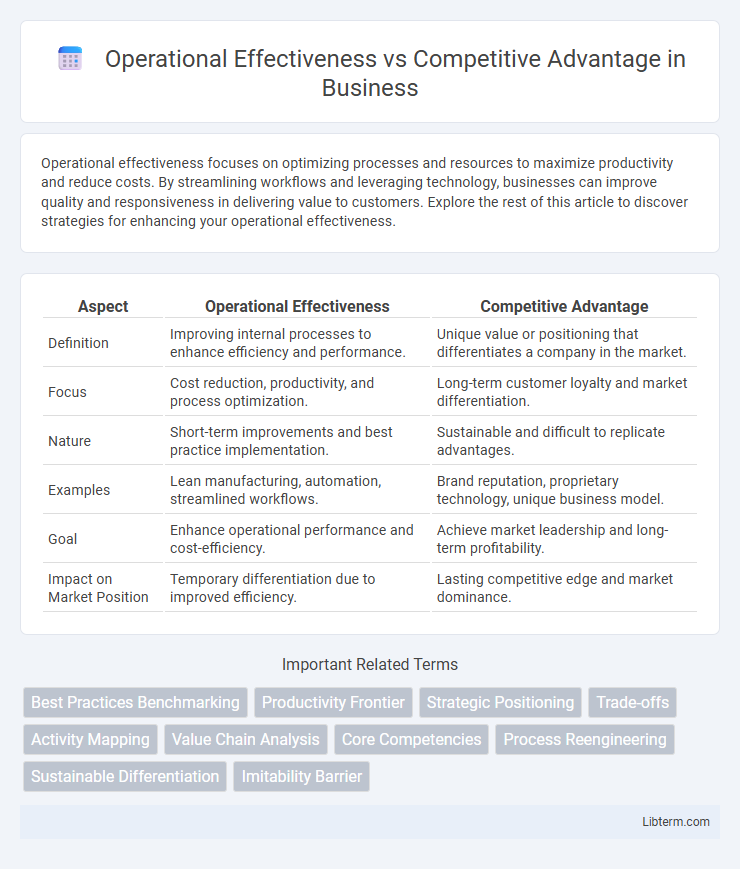Operational effectiveness focuses on optimizing processes and resources to maximize productivity and reduce costs. By streamlining workflows and leveraging technology, businesses can improve quality and responsiveness in delivering value to customers. Explore the rest of this article to discover strategies for enhancing your operational effectiveness.
Table of Comparison
| Aspect | Operational Effectiveness | Competitive Advantage |
|---|---|---|
| Definition | Improving internal processes to enhance efficiency and performance. | Unique value or positioning that differentiates a company in the market. |
| Focus | Cost reduction, productivity, and process optimization. | Long-term customer loyalty and market differentiation. |
| Nature | Short-term improvements and best practice implementation. | Sustainable and difficult to replicate advantages. |
| Examples | Lean manufacturing, automation, streamlined workflows. | Brand reputation, proprietary technology, unique business model. |
| Goal | Enhance operational performance and cost-efficiency. | Achieve market leadership and long-term profitability. |
| Impact on Market Position | Temporary differentiation due to improved efficiency. | Lasting competitive edge and market dominance. |
Defining Operational Effectiveness
Operational effectiveness refers to performing similar activities better than rivals by reducing costs, improving quality, and streamlining processes, which enhances productivity and efficiency. It centers on optimizing internal operations such as supply chain management, product development, and customer service to achieve superior performance. While operational effectiveness is essential for maintaining competitiveness, it alone cannot provide a sustainable competitive advantage due to easy replication by competitors.
Understanding Competitive Advantage
Competitive advantage arises from unique resources, capabilities, and strategies that allow a company to deliver superior value compared to competitors. Unlike operational effectiveness, which involves performing similar activities better, competitive advantage requires differentiation that is sustainable and difficult to replicate. Key drivers include innovation, brand reputation, exclusive access to resources, and strategic positioning within the market.
Key Differences Between Operational Effectiveness and Competitive Advantage
Operational effectiveness involves performing similar activities better than rivals, emphasizing efficiency, quality, and speed, while competitive advantage centers on creating unique value that competitors cannot easily replicate. Operational effectiveness improves internal processes and reduces costs, but competitive advantage requires strategic positioning and innovation to establish a sustainable market edge. Firms gaining only operational effectiveness risk commoditization, whereas those securing competitive advantage achieve superior profitability and market leadership.
The Role of Efficiency in Operational Effectiveness
Operational effectiveness centers on maximizing efficiency by streamlining processes, reducing costs, and improving productivity to deliver value more effectively than competitors. High efficiency in operational tasks enables organizations to optimize resource utilization, shorten production cycles, and enhance product quality, directly contributing to superior operational performance. While operational effectiveness improves internal capabilities, sustainable competitive advantage requires unique strategies beyond mere efficiency, emphasizing innovation and market positioning.
Sustainable versus Temporary Advantage
Operational effectiveness involves performing similar activities better than rivals, leading to temporary advantages that competitors can quickly replicate. Competitive advantage arises from unique strategies or resources that create sustainable value, difficult for others to imitate. Sustainable advantage ensures long-term market leadership, while operational effectiveness alone often results in short-term gains vulnerable to competitive pressures.
Examples of Operational Effectiveness in Business
Operational effectiveness in business is exemplified by companies like Toyota, which utilizes lean manufacturing to reduce waste and improve productivity, and Walmart, known for its efficient supply chain management and cost leadership. Amazon's use of automated warehouses and advanced data analytics optimizes order fulfillment speed and inventory management to enhance overall operational performance. These examples highlight how operational effectiveness improves internal processes but does not guarantee a sustainable competitive advantage without unique strategic positioning.
How Companies Achieve Competitive Advantage
Companies achieve competitive advantage by implementing unique strategies that differentiate their products or services, such as innovation, brand reputation, and customer experience. Operational effectiveness improves productivity and reduces costs but cannot sustain competitive advantage alone due to its susceptibility to imitation. Sustainable competitive advantage relies on creating value that competitors cannot easily replicate through resources like proprietary technology, exclusive partnerships, and strong intellectual property.
Operational Effectiveness: Benefits and Limitations
Operational effectiveness improves efficiency by optimizing processes, reducing costs, and enhancing productivity, leading to better resource utilization and faster turnaround times. It enables companies to meet industry standards and customer expectations consistently, which is essential for maintaining competitiveness. However, relying solely on operational effectiveness can result in commoditized offerings and limited differentiation, making it difficult to sustain a long-term competitive advantage in dynamic markets.
Why Competitive Advantage Drives Long-Term Success
Operational effectiveness improves efficiency by optimizing processes and reducing costs, but competitive advantage stems from unique value propositions that differentiate a company in the marketplace. Sustainable competitive advantage drives long-term success by creating barriers to entry and fostering customer loyalty, which operational improvements alone cannot achieve. Firms with distinct capabilities or innovations maintain profitability and market leadership despite competitive pressures and technological changes.
Integrating Operational Effectiveness with Competitive Strategy
Integrating operational effectiveness with competitive strategy requires aligning core business processes with unique value propositions to sustain long-term market leadership. Emphasizing continuous improvement in operational capabilities while differentiating through innovation and customer-centric offerings strengthens barriers to entry and fosters competitive advantage. Companies that balance efficiency enhancements with strategic positioning achieve superior financial performance and resilience in dynamic industries.
Operational Effectiveness Infographic

 libterm.com
libterm.com